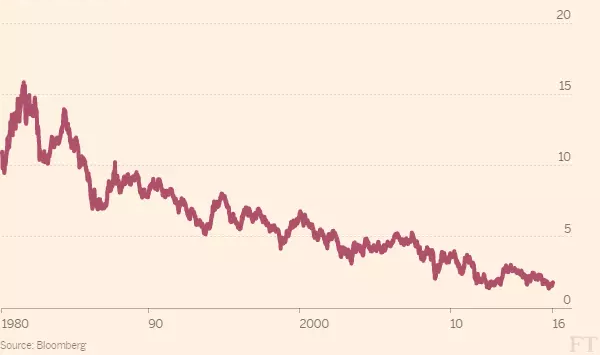It’s no secret that the consuming passion of fixed income investors is “the search for yield.” The Financial Times offered a nice snapshot of the problem; here is the income available (the yield) from the super-safe benchmark 10-year Treasury bonds:

That’s a picture of a bull market in bonds: as investors are willing to pay more for a bond, the yield they earn from it falls. That relentless move from 16% down to 2% understates the global challenge where there are about $9 trillion in investment-grade bonds that generate a negative yield (“fixed negative-income funds”?)
A painfully common response has been for investors to swallow hard and buy higher-risk assets for what was supposed to be the lower-risk portion of their portfolios. As part of the Financial Times Investing 2.0: Unlocking Yield special report, David Oakley notes:
Pension funds and insurance companies have increasingly embraced riskier assets in their hunt for higher returns over the past five years. Alternative assets such as property, infrastructure, private equity and hedge funds have been bought up by institutional investors in a world where yields on safer government bonds have hit rock bottom.
Total assets managed by the 100 largest alternative investment managers rose to $3.6tn this year … as these assets have become more embedded in the portfolios of pension funds and insurance groups…
The OECD, the Paris-based group of mostly rich nations, warned last year that pension funds and insurance companies faced a growing threat of insolvency because of their increased allocations to riskier assets. (11/28/2016)
T. Rowe Price has launched the T. Rowe Price Total Return Fund in response to exactly that set of pressures. Unlike most funds with the “total return” moniker, it’s a purely fixed income fund investing in a diversified portfolio of U.S. government bonds, corporate bonds, bank loans and various types of mortgage-backed and asset-backed securities. The fund’s exposure to corporate bonds is capped at 35% and foreign currency exposure is capped at 20%. Unlikely many panicked professional investors, it’s targeting the investment grade universe rather than taking ill-defined risks on alternatives, private placements and similarly shady ventures.
It is designed “to address the challenges of the current market environment, including low interest rates, potential for volatility, stretched valuations and impaired market liquidity.” The fund will primarily invest in intermediate-term bonds and will employ a U.S.-focused, multi-sector approach. Manager Andy McCormick claims to be pursuing “the characteristics of a high-grade bond portfolio – diversification of risk away from stocks and steady cash flow from the fund’s holdings.”
The fund is co-managed by Andy McCormick, head of the U.S. taxable bond team and manager of the four-star T. Rowe Price GNMA Fund (PRGMX) and Chris Brown who seems mostly to have managed money on Price’s behalf for private and international investors.
Bottom line: it’s definitely worth a look. T. Rowe Price is far more professional, risk-conscious and trend-avoidant than its peers. Its multi-sector income funds (Credit Opportunities, Global Multi-sector Bond, Personal Strategy: Income, Spectrum Income) are generally exceedingly well-built and are consistently strong performers. Folks equally anxious about low-yields and the unintended consequences of chasing higher yields should put Price Total Return on their watch list.
The fund launched on October 31, 2016. The minimum initial investment for Investor shares is $2500 and the initial expense ratio after waivers is .57%, which is well below the category average of 0.79%. There’s a bit more detail at the fund’s homepage.













